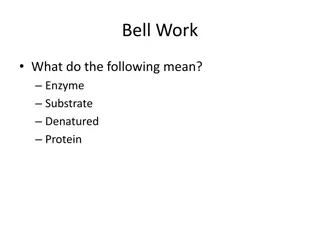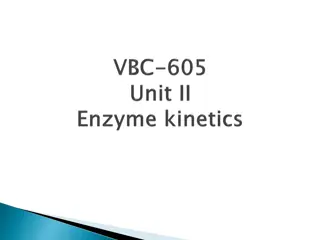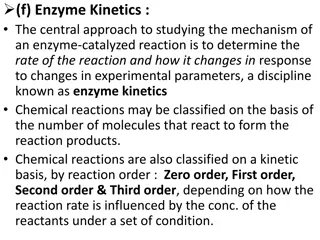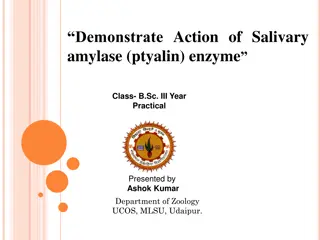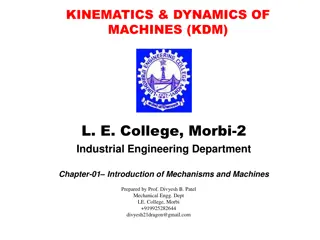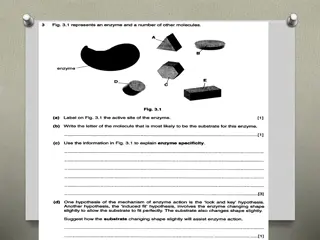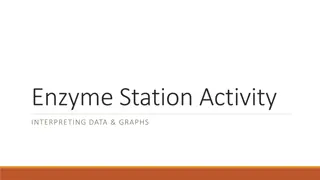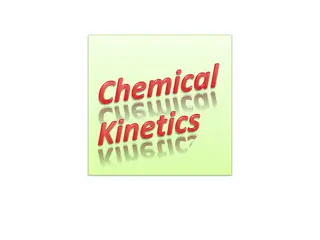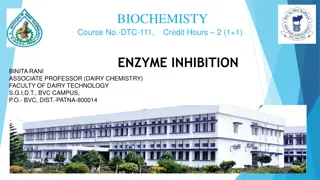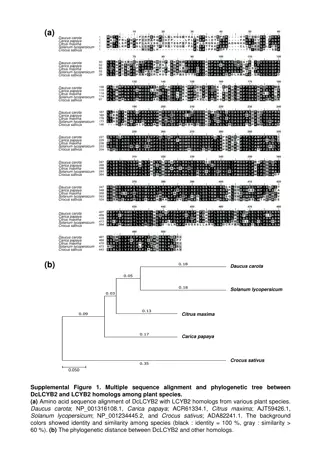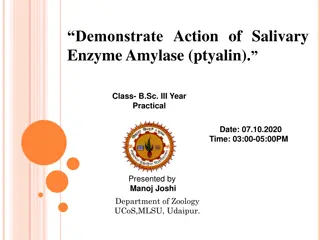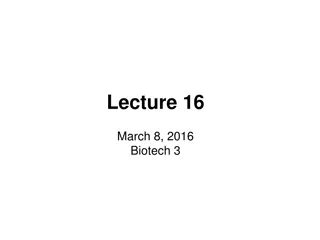ENZYME KINETICS
In enzyme kinetics, the presence of specific enzymes accelerates reactions, with substrate conversion catalyzed swiftly and specifically. Enzyme units and specific activity play critical roles, impacting reaction rates and product formation. The Michaelis-Menten Equation explains enzyme behavior, with catalysis rates varying with substrate concentration. Explore the impact of substrate concentration on reaction velocity and the time-dependent product formation.
Download Presentation

Please find below an Image/Link to download the presentation.
The content on the website is provided AS IS for your information and personal use only. It may not be sold, licensed, or shared on other websites without obtaining consent from the author.If you encounter any issues during the download, it is possible that the publisher has removed the file from their server.
You are allowed to download the files provided on this website for personal or commercial use, subject to the condition that they are used lawfully. All files are the property of their respective owners.
The content on the website is provided AS IS for your information and personal use only. It may not be sold, licensed, or shared on other websites without obtaining consent from the author.
E N D
Presentation Transcript
BIOCHEMISTY Course No.-DTC-111, Credit Hours 2 (1+1) ENZYME KINETICS BINITA RANI ASSOCIATE PROFESSOR (DAIRY CHEMISTRY) FACULTY OF DAIRY TECHNOLOGY S.G.I.D.T., BVC CAMPUS, P.O.- BVC, DIST.-PATNA-800014
In the absence of enzyme => conversion of S to P is slow and uncontrolled. In presence of a specific enzyme => S is converted swiftly and specifically to product. Enzyme is specific => it will not convert A to B or X to Y. Enzymes also provide => rate acceleration. On comparing rate of a chemical reaction in solution => with => rate of the same reaction with the reactants bound to enzyme =>enzyme reaction will occur up to 1014 times faster.
A unit is => amount of enzyme => that will catalyze the conversion of 1 mol of substrate to product in 1 min under a given set of conditions. Units of enzyme can be converted to => milligrams of enzyme by a conversion factor called => specific activity. Specific activity is => amount of enzyme activity per milligram of protein (micromoles of product formed / minute / milligram of protein, or units per milligram).
For a pure enzyme => under a defined set of conditions => the specific activity is a constant; however, different enzymes have => different specific activities. An enzyme assay is => act of measuring how fast a given (or unknown) amount of enzyme will convert substrate to product - act of measuring a velocity. Velocity (rate, v, activity, d[P]/dt, d[S]/dt) is => how fast an enzyme converts substrate to product => the amount of substrate consumed, or product formed per unit time. Units are micromoles per minute ( mol/min) units.
The Michaelis-Menten Equation primary function of enzymes => to enhance rates of reactions => so that they are compatible with => needs of the organism. To understand how enzymes function => we need a kinetic description of their activity. For many enzymes => the rate of catalysis V0 => which is defined as number of moles of product formed per second => varies with substrate concentration [S]. The rate of catalysis => rises linearly as substrate concentration increases and => then begins to level off and approach a maximum at higher substrate concentrations.
Effect of substrate concentration on the initial velocity of an enzyme-catalyzed reaction
The extent of product formation is determined => as a function of time => for a series of substrate concentrations. In each case => amount of product formed increases with time => although eventually => a time is reached when => there is no net change in the concentration of S or P. Enzyme is still actively converting => substrate into product and visa versa => but reaction equilibrium has been attained. We define V0 as => rate of increase in product with time when [P] is low => that is => at times close to zero (hence, V0). Thus, V0 is determined for each substrate concentration => by measuring the rate of product formation at early times before P accumulates .
We begin our kinetic examination of enzyme activity with the graph shown in Figure. At a fixed concentration of enzyme => V 0 is almost linearly proportional to [S] when [S] is small but is nearly independent of [S] when [S] is large. In 1913, Leonor Michaelis and Maud Menten proposed => a simple model to => account for these kinetic characteristics. The critical feature in their treatment is => that a specific ES complex is a necessary intermediate in catalysis. The model proposed => is the simplest one that accounts for the kinetic properties of many enzymes.
To simplify matters => we will work under steady-state assumption. In a steady state => the concentrations of intermediates, in this case [ES] => stay the same even if => concentrations of starting materials and products are changing. This occurs => when the rates of formation and breakdown of the ES complex are equal. Setting the right-hand sides of equations 3 and 4 equal gives
Now let us examine the numerator of equation 8. The concentration of uncombined substrate [S] is very nearly => equal to the total substrate concentration => provided that the concentration of enzyme is much lower than that of substrate. The concentration of uncombined enzyme [E] is equal to the total enzyme concentration [E]T minus the concentration of the ES complex.
At very low substrate concentration => when [S] is much less than K M, V0 = (V max/K M)[S] => that is => the rate is directly proportional to the substrate concentration. At high substrate concentration => when [S] is much greater than K M, V0 = V max => that is => the rate is maximal => independent of substrate concentration. The meaning of K M is evident from equation 15. When V0 = V max/2 Then [S] = KM Thus, K M is equal to the substrate concentration at which => the reaction rate is half its maximal value. Km is an important characteristic of an enzyme-catalyzed reaction and is significant for => its biological function. For most enzymes, Kmlies between 10-1 and 10-7 M.
The Significance of Km and Vmax Values Km value for an enzyme depends on => particular substrate and on environmental conditions => pH, temperature, and ionic strength. Km is => concentration of substrate at which half the active sites are filled. Thus => Km provides a measure of the substrate concentration required for => significant catalysis to occur. Km is equal to => dissociation constant of ES complex if k2 is < k-1 . High Km indicates => weak binding => a low Km indicates strong binding. Km indicates affinity of ES complex only when k- 1 is > k2. The maximal rate => V max => reveals the turnover number of an enzyme => i.e. the number of substrate molecules converted into product by an enzyme molecule in a unit time => when enzyme is fully saturated with substrate.
The Double-Reciprocal Plot Michaelis-Menten equation can be algebraically transformed into equations that are more useful in plotting experimental data
This form of Michaelis-Menten equation is called => Lineweaver-Burk equation. For enzymes obeying the Michaelis-Menten relationship => a plot of 1/V0 versus 1/[S] yields => a straight line. This line has a slope of Km/Vmax => an intercept of 1/Vmax on the 1/V0 axis, and => an intercept of -1/Km on the 1/[S] axis. The Double- Reciprocal Plot
The double-reciprocal presentation => also called a Lineweaver-Burk plot => has the great advantage of allowing a more accurate determination of => Vmax, which can only be approximated from => a simple plot of V0 versus [S]. Double-reciprocal plot of enzyme reaction rates is very useful in => distinguishing between certain types of enzymatic reaction mechanisms and => in analyzing enzyme inhibition.
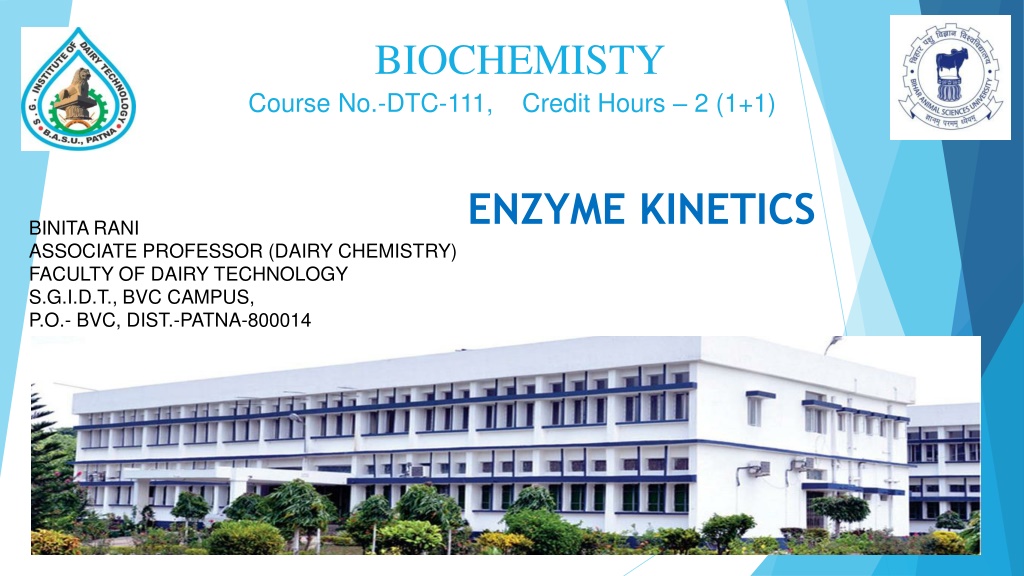
 undefined
undefined










